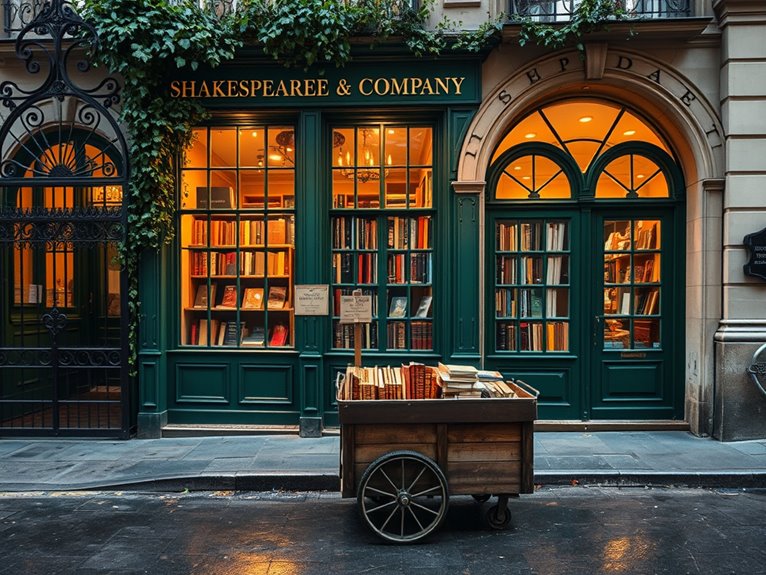
8 Best Literary Landmarks in Paris for Book Lovers
I've curated Paris's top literary landmarks that'll make any book lover's heart skip a beat! Start at Shakespeare and Company Bookstore, then sip coffee where Hemingway did at Café de Flore and Les Deux Magots. Pay respects to literary giants at Père Lachaise Cemetery, explore Victor Hugo's house, wander the Latin Quarter, trace Orwell's footsteps, and visit Hemingway's apartment. These storied spots hold countless tales waiting to transport you through time!
Shakespeare and Company Bookstore
The legendary Shakespeare and Company bookstore stands as a beacon of literary history in Paris's Latin Quarter, mere steps from the Seine and Notre-Dame Cathedral. This English-language bookshop has served as a gathering place for literary giants like James Joyce, Ernest Hemingway, and Allen Ginsberg, while continuing to welcome new generations of writers and readers from around the world.
Founded in 1919 by Sylvia Beach and later reopened in 1951 by George Whitman, this beloved institution represents more than just a bookstore – it's a living piece of literary heritage where aspiring writers can still find refuge through its "Tumbleweed" program, sleeping among the books in exchange for help around the store and a commitment to reading and writing daily.
Quick Facts:
- Opening Hours: Mon-Sat 10:00-22:00, Sun 12:30-20:00
- Photography: Allowed outside; interior photos require permission
- Cost: Free entry
- Best Time to Visit: Weekday mornings or late evenings
- Payment Methods: Cash and credit cards accepted
- Special Programs: Writers-in-residence ("Tumbleweed" program)
- Location: 37 rue de la Bûcherie, 75005 Paris
The main bookshop occupies two floors packed with new and used English-language books, featuring everything from contemporary bestsellers to rare first editions. The adjacent café, opened in 2015, serves organic coffee, fresh baked goods, and light meals while offering stunning views of Notre-Dame. The store's most unique feature is its second-floor reading library, where visitors can discover century-old volumes and hand-written notes from past literary residents.
Hidden behind the general collection lies the rare book room, accessible by request only, housing valuable first editions and signed copies. The store's famous "Tumbleweed" program continues George Whitman's tradition of hosting young writers, with over 30,000 guests having stayed at the bookstore since its opening. An insider tip: check the store's event calendar for frequent readings, workshops, and literary festivals that aren't widely advertised.
Pro Tips:
The best photographs of the storefront can be captured in the early morning light before crowds gather, particularly from the small plaza across the street. To fully experience the store's magic, visit on a weekday around opening time or during the last hour before closing when the tourist crowds thin out and you can browse peacefully among the books.
Practical Advice:
While the store can get crowded, especially during peak tourist season, patience is rewarded with the discovery of hidden literary treasures. Bring cash for second-hand books, as some rare finds aren't priced for card payments. Consider joining their Friends of Shakespeare and Company membership program for special access to events and discounts, particularly if planning multiple visits during your stay in Paris.
Le Café De Flore
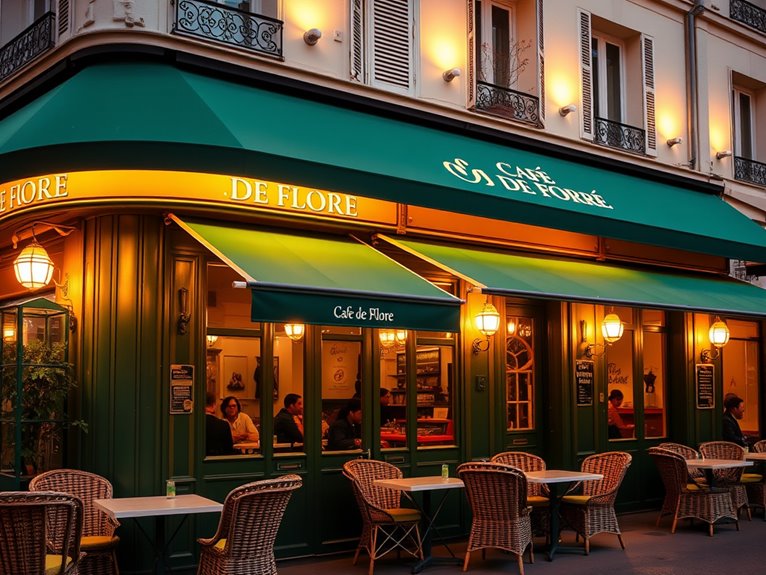
Located at the corner of Boulevard Saint-Germain and Rue Saint-Benoît, Le Café de Flore stands as one of Paris's most iconic literary cafés, having served as a creative sanctuary for intellectuals and artists since 1887. This historic establishment witnessed the birth of numerous literary movements and philosophical debates, with regular patrons including Jean-Paul Sartre, Simone de Beauvoir, and Albert Camus.
The café's enduring charm lies in its preservation of classic Art Deco interiors, red leather banquettes, and mahogany paneling that transport visitors to the heyday of Paris's intellectual scene. Today, while maintaining its status as a cultural landmark, Le Café de Flore continues to attract writers, artists, and curious travelers seeking to experience the authentic atmosphere that inspired some of the 20th century's greatest thinkers.
Quick Facts:
- Opening Hours: Daily 7:30 AM – 1:30 AM
- Price Range: €€€ (Higher end)
- Reservations: Not accepted
- Famous Menu Items: Hot chocolate, Croque Monsieur
- Photography: Permitted outside; interior photos at staff discretion
- Best Times to Visit: Weekdays 3-5 PM for fewer crowds
- Dress Code: Smart casual recommended
The Literary Legacy
Le Café de Flore's most celebrated period was during the post-war years when it became the headquarters of existentialism. Sartre and de Beauvoir would spend hours writing at their preferred tables, now marked with discrete plaques. The upstairs room, with its large windows overlooking Saint-Germain-des-Prés, was where many philosophical debates took place, and this space remains largely unchanged. Insider tip: Ask the long-serving staff about the specific tables where famous writers sat – some waiters have worked here for decades and share fascinating historical anecdotes.
The Modern Experience
While tourist crowds are common, Le Café de Flore maintains its authentic Parisian café atmosphere. The menu features traditional French café fare, including their renowned hot chocolate (served in Art Deco-style porcelain) and classic breakfast options. Located at 172 Boulevard Saint-Germain, 75006 Paris, the café is easily accessible via Metro stations Saint-Germain-des-Prés or Mabillon. Unique feature: The café still maintains a subscription to various international newspapers, continuing its tradition as a place of cultural exchange.
Pro Tips:
Early morning visits (before 9 AM) offer the most authentic experience, with local regulars going about their daily routines. To truly channel the spirit of the literary giants, bring a notebook and settle in for a few hours of people-watching and writing. The corner tables provide the best vantage points for observing both the street life and the café's interior dynamics.
Practical Advice:
While prices are significantly higher than typical Parisian cafés, consider the cost as admission to a living museum of literary history. For the most rewarding experience, avoid peak tourist hours (12-2 PM and 6-8 PM), and be prepared to wait for a table during busy periods. The staff appreciates basic French greetings and ordering attempts, even if you ultimately continue in English.
Père Lachaise Cemetery's Literary Giants
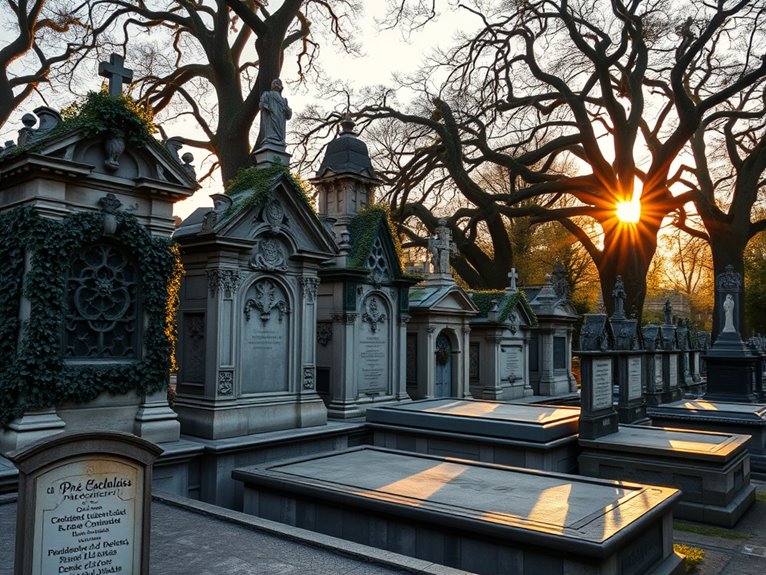
The world's most visited cemetery serves as the eternal resting place for some of literature's most influential voices, making Père Lachaise Cemetery a powerful pilgrimage site for book lovers and history enthusiasts alike. Sprawling across 110 acres of carefully manicured grounds, this 19th-century necropolis houses the graves of numerous literary luminaries who shaped the course of French and world literature.
Walking through the cemetery's cobblestone paths feels like traversing through the pages of a literary anthology, where each tombstone tells a story of creative genius and artistic legacy. From Oscar Wilde's kiss-covered tomb to Marcel Proust's modest grave, these final resting places offer intimate connections to the writers who made Paris the literary capital of the world.
Quick Facts:
- Opening Hours: March-November 8:00-18:00; November-March 8:00-17:30
- Admission: Free
- Best Time to Visit: Early morning or late afternoon for ideal lighting and fewer tourists
- Photography: Allowed, but be respectful of mourners and current ceremonies
- Guided Tours: Available in multiple languages (€12-15)
- Accessibility: Hilly terrain, comfortable walking shoes essential
- Maps: Available at main entrance (€2)
Notable Literary Graves:
Oscar Wilde (1854-1900)
The most visited literary grave features an Art Deco angel sculpture by Jacob Epstein. Located in Division 89, the tomb is covered with lipstick kisses from admirers, despite a protective barrier installed in 2011. Insider tip: Visit early morning to catch the sculpture in dramatic lighting for photographs.
Marcel Proust (1871-1922)
A simple black marble tombstone marks the author's grave in Division 85. The understated memorial contrasts with the writer's elaborate prose style. Insider tip: Look for small madeleine cookies occasionally left by fans, referencing his famous passage about memory and taste.
Gertrude Stein (1874-1946)
Shared with Alice B. Toklas, this grave in Division 94 features a simple headstone with both names. Visitors often leave stones, following Jewish tradition. Insider tip: The surrounding area contains many other artistic luminaries from Stein's social circle.
Honoré de Balzac (1799-1850)
The celebrated French novelist's tomb in Division 48 features a bronze bust on a tall pedestal. Look for the well-worn path created by devoted readers who regularly visit. Insider tip: Visit during fall when surrounding trees create a fitting atmosphere for contemplating his realist works.
Pro Tips:
The cemetery's vastness can be overwhelming, so download a digital map beforehand or purchase the official guide at the entrance. The most efficient route begins at the main entrance and follows the curved path up the hill, hitting major literary sites in chronological order. Consider visiting during shoulder season (March-April or September-October) when the grounds are less crowded and the weather is mild.
Practical Advice:
Père Lachaise requires significant walking on uneven terrain. Wear sturdy shoes and bring water, especially during summer months. Respect ongoing funerals and maintain appropriate cemetery etiquette. While photography is permitted, avoid sitting on or touching the tombs. The cemetery closes promptly at posted times, so plan to exit 30 minutes before closing to avoid being locked in.
Les Deux Magots
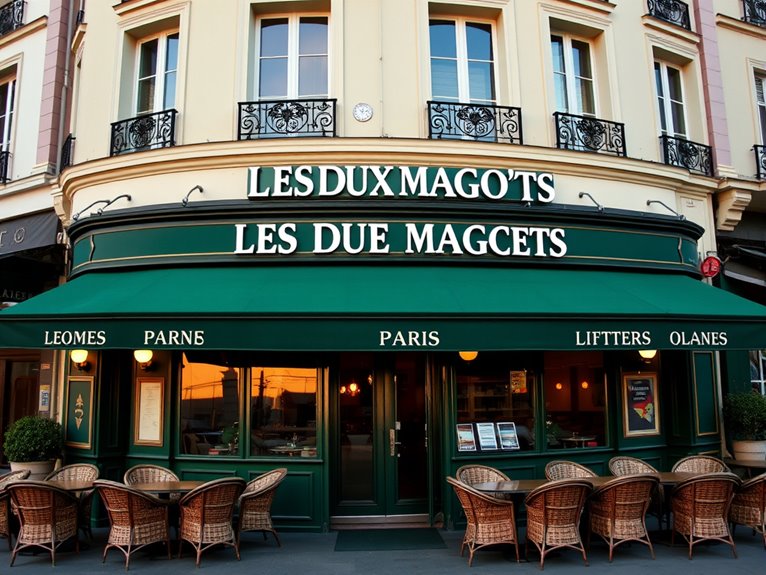
Les Deux Magots stands as one of Paris's most iconic literary cafés, a cultural cornerstone where intellectual giants of the 20th century shaped modern thought over cups of coffee and heated debates. Located in the heart of Saint-Germain-des-Prés, this historic establishment has hosted luminaries like Jean-Paul Sartre, Simone de Beauvoir, Ernest Hemingway, and Pablo Picasso, cementing its status as a sanctuary for writers, artists, and philosophers.
Since its establishment in 1885, Les Deux Magots has maintained its distinctive character while evolving from a silk merchant's shop to a café-restaurant that epitomizes Parisian café culture. The name, derived from two Chinese figurines that still watch over the main room, reflects its fascinating transformation from an exotic goods store to a intellectual haven that continues to draw literary enthusiasts and culture seekers from around the world.
Quick Facts:
- Opening Hours: Daily 7:30 AM – 1:00 AM
- Price Range: €€€ (Premium pricing for the historic experience)
- Reservation Status: Not required but recommended for peak times
- Best Times to Visit: Early morning (8-10 AM) or late afternoon (4-6 PM)
- Photography: Allowed, best lighting during morning hours
- Dress Code: Smart casual recommended
- Languages: Menus available in French, English, Spanish, and Japanese
What Makes It Special:
Les Deux Magots offers more than just coffee and croissants; it provides an immersive journey into Paris's intellectual history. The café's original Art Deco interior, including the iconic green banquettes and brass fixtures, remains largely unchanged since its heyday. The establishment still awards the Prix des Deux Magots, a prestigious literary prize created in 1933 as an alternative to the mainstream Prix Goncourt.
Location and Practical Details:
Situated at 6 Place Saint-Germain-des-Prés in the 6th arrondissement, the café is easily accessible via Metro lines 4 (Saint-Germain-des-Prés station). The outdoor terrace offers prime people-watching opportunities, while the interior preserves the ambiance that attracted countless artists and writers. Prices reflect the historic setting, with coffee starting at €7 and the famous hot chocolate at €8.50.
Insider Tip: The café maintains a special "Writer's Corner" where Sartre and de Beauvoir regularly sat – table 18. While it's not marked, knowledgeable servers can point it out, and sitting there requires no additional charge.
Pro Tips:
To truly experience Les Deux Magots like a literary legend, visit during off-peak hours when the atmosphere is more contemplative. Order the signature breakfast (served until 11:30 AM) and request a table with a view of both the church of Saint-Germain-des-Prés and the street scene. The morning light through the café's windows creates perfect conditions for photography, and the service is generally more attentive during quieter periods.
Practical Advice:
While Les Deux Magots welcomes tourists, it maintains certain expectations of its patrons. Taking time over your coffee or meal is encouraged – rushing through the experience misses the point entirely. Consider bringing a book or journal to fully embrace the literary atmosphere, and don't hesitate to engage with the knowledgeable staff about the café's history. While prices are higher than typical Parisian cafés, the cultural and historical value justifies the premium for those seeking an authentic connection to Paris's literary heritage.
Victor Hugo's House at Place Des Vosges

The museum spans the second floor of the Hôtel de Rohan-Guéménée, preserving the essence of Hugo's domestic life during his most productive writing period. Each room tells a different chapter of his story, from his writing desk where masterpieces were born to the ornate Chinese-inspired dining room that reflects his eclectic taste in interior design.
Quick Facts:
- Opening Hours: Tuesday to Sunday, 10:00 AM – 6:00 PM (Closed Mondays)
- Admission: Free entry to permanent collections
- Best Times to Visit: Weekday mornings, especially Tuesday and Thursday
- Photography: Allowed without flash
- Accessibility: Limited; historic building with stairs
- Audio Guide: Available in multiple languages (€5)
- Average Visit Duration: 1-1.5 hours
The Antechamber and Chinese Drawing Room showcase Hugo's passion for interior design and his collection of Asian art. The preserved furniture and decorations reflect his artistic vision and the fashionable Oriental influences of the period. The red damask walls and intricate wooden panels create an atmosphere that transports visitors to 19th-century Paris. Insider tip: Look for the hidden symbols in the Chinese-inspired wallpaper, which Hugo himself helped design.
The writer's bedroom features the desk where he wrote standing up, a habit he maintained throughout his life. The room offers views over Place des Vosges, providing context for the urban inspiration behind many of his works. An often-overlooked detail is the small alcove where Hugo kept his most precious manuscripts.
The dining room, perhaps the most impressive space, displays Hugo's original furniture and his collection of porcelain. The ceiling, painted to resemble a tent, was designed by Hugo himself. Lesser-known fact: The table still bears marks from the numerous political discussions and literary gatherings that took place here.
Pro Tips:
Visit during the golden hour (about an hour before sunset) when the light streams through the windows, illuminating the antique furnishings and creating an atmospheric experience perfect for photography. Consider combining your visit with a stroll around Place des Vosges and its arcades, ideally in the morning before the crowds arrive. The museum often hosts temporary exhibitions related to Hugo's work and life – check the schedule in advance to enhance your visit.
Practical Advice:
Book a guided tour in advance for the most enriching experience, as many fascinating details about Hugo's life and work might otherwise go unnoticed. The museum shop offers unique editions of Hugo's works and period-inspired items that make excellent souvenirs. Be aware that the historic nature of the building means some areas have limited accessibility, and while entry is free, special exhibitions may require a separate ticket.
The Latin Quarter's Literary Walk
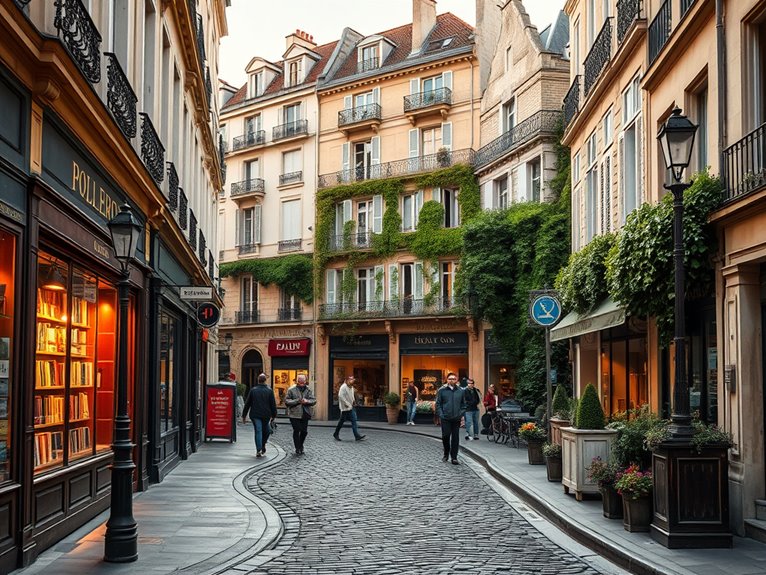
The cobblestone streets of Paris's Latin Quarter have witnessed countless literary giants crafting masterpieces in dimly lit cafés and cramped apartments. This historic neighborhood, centered around the Sorbonne University, earned its name from the medieval students who spoke Latin while studying nearby. Today, the area remains a reflection of the literary legends who shaped modern literature, from Ernest Hemingway to Simone de Beauvoir.
Walking through the Latin Quarter's literary landmarks offers an intimate glimpse into the creative spaces that inspired some of the world's most celebrated works. This self-guided walking tour connects visitors with the haunts of famous writers, iconic bookshops, and historic cafés where literary movements were born and artistic revolutionaries gathered to debate philosophy and politics.
Quick Facts:
- Best visiting hours: 10:00 AM – 6:00 PM (avoid student rush hours)
- Cost: Free (excluding optional café stops and bookstore purchases)
- Duration: 2-3 hours at a leisurely pace
- Photography: Early morning offers best lighting and fewer crowds
- Accessibility: Mostly flat terrain, some narrow streets
- Season: Year-round, but spring and fall offer ideal weather
Key Stops:
Shakespeare and Company Bookstore
Historic English-language bookstore that served as a gathering place for Lost Generation writers. Located at 37 rue de la Bûcherie, this iconic shop offers new and used books, regular readings, and a famous "tumbleweed" program for traveling writers. Insider tip: Visit the second floor's reading room to find handwritten notes from past visitors tucked into books.
Café de Flore
This historic café at 172 Boulevard Saint-Germain was the preferred writing spot of Jean-Paul Sartre and Simone de Beauvoir. Still operating daily from 7:30 AM to 1:30 AM, it maintains its authentic 1920s décor. Insider tip: The back corner table by the stairs was Sartre's favorite spot – arrive early to claim it.
La Closerie des Lilas
Hemingway's preferred writing location at 171 Boulevard du Montparnasse features a brass plaque marking his regular seat. Open daily for lunch and dinner, reservations recommended. Insider tip: The restaurant maintains a guest book dating back to the 1920s – ask to see it.
Pro Tips:
For the most atmospheric experience, begin the walk at dawn when the quarter's narrow streets are quiet and cafés are just opening. Carry a small notebook to jot down observations or sketch scenes – many cafés welcome lingering customers who order a coffee and engage in creative pursuits. Consider visiting during the off-season months (November-March) when tourist crowds thin and the literary ambiance feels more authentic.
Practical Advice:
Most historic cafés in the Latin Quarter accept credit cards but prefer cash for small purchases. Wear comfortable walking shoes suitable for cobblestone streets, and bring a rain jacket as many historic spots have limited indoor waiting areas. Download offline maps as the narrow streets can be confusing to navigate. Many establishments offer literary walking maps – pick one up at Shakespeare and Company or the tourist office near the Panthéon.
George Orwell's Down and Out Haunts
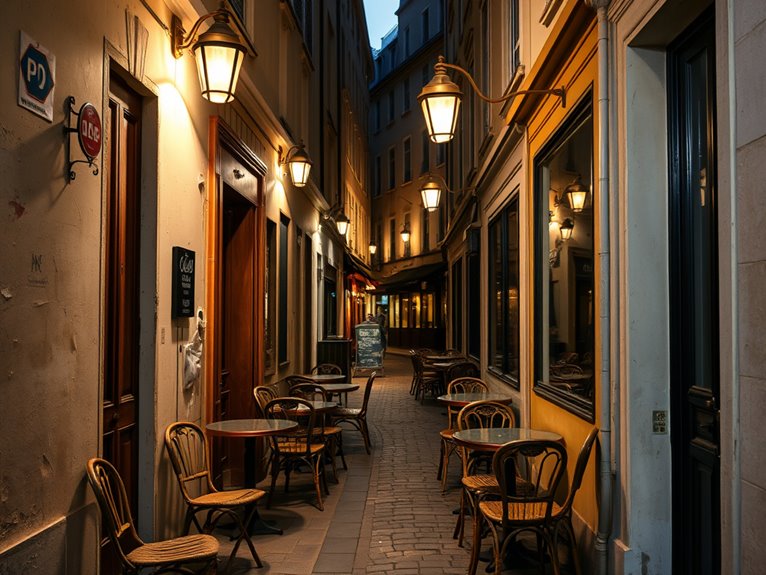
Following George Orwell's footsteps through Paris reveals the gritty underbelly of the City of Light that inspired his seminal work "Down and Out in Paris and London." These locations offer a stark contrast to the glamorous cafés and boutiques typically associated with Paris, instead showcasing the working-class neighborhoods and humble establishments where Orwell experienced poverty firsthand in the late 1920s.
The places where Orwell washed dishes, slept in cheap lodgings, and observed the struggles of Paris's working poor still exist today, though many have been transformed by gentrification. This guide explores the key locations that shaped Orwell's perspective and writing, providing literary enthusiasts and history buffs with an alternative view of Paris that few tourists experience.
Quick Facts:
- Best visiting season: Year-round, though spring and fall offer comfortable walking weather
- Cost range: Free for external viewing; €5-15 for establishments still operating
- Photography: Permitted outside buildings; check individual policies for interiors
- Walking distance: Approximately 4 kilometers total between sites
- Accessibility: Most sites in working-class neighborhoods, some off typical tourist routes
- Guide availability: Self-guided or literary walking tours (€25-40)
Hotel X (now Hotel de la Seine)
Located in the 5th arrondissement, this building housed the hotel where Orwell worked as a plongeur (dishwasher). While the interior has been completely renovated, the exterior maintains much of its original character. The narrow service entrance Orwell used still exists, though it's now a fire exit.
Insider tip: Visit during off-hours (2-5 PM) when staff are more likely to allow a peek at the basement kitchen area.
Rue du Pot de Fer
The street where Orwell lived in a bug-infested room remains largely unchanged. Number 6 was his residence, though the specific building is disputed. The street maintains its working-class character despite the neighborhood's gentrification.
Insider tip: The local café at the corner serves traditional working-class French cuisine at reasonable prices, much as it did in Orwell's time.
Auberge de Jehan Cottard
Though the original restaurant is gone, this location in the 11th arrondissement housed the establishment where Orwell had his most challenging experiences as a plongeur. A plaque commemorates the site.
Insider tip: The current restaurant on the premises offers a special "Orwell Menu" featuring dishes mentioned in the book.
Pro Tips:
For the most authentic experience, visit these locations early morning when restaurant workers are receiving deliveries and preparing for the day, just as Orwell would have experienced. Combine the tour with visits to modern-day social justice organizations in the area to understand how poverty and labor issues have evolved in Paris since Orwell's time.
Practical Advice:
Many of these locations are in working neighborhoods where English isn't widely spoken. Carry a printed map and basic French phrases. Some areas can be rough after dark, so plan to complete the tour during daylight hours. Consider joining a guided literary tour for additional historical context and access to normally restricted areas.
Hemingway's Paris Apartment
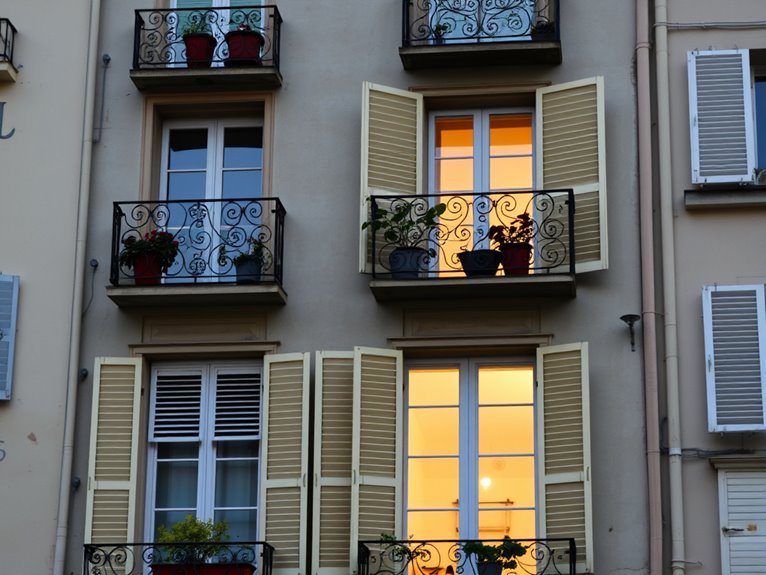
Ernest Hemingway's former residence at 74 rue du Cardinal Lemoine stands as one of the most significant literary landmarks in Paris's Latin Quarter. This modest apartment, where the legendary author lived with his first wife Hadley from 1922 to 1923, witnessed the birth of his earliest serious works and played an essential role in shaping his writing career. The two-room flat, situated on the third floor of a typical Parisian building, became the setting for numerous passages in "A Moveable Feast," his posthumously published memoir of his Paris years.
The apartment represents more than just a historical residence; it embodies the romantic notion of the struggling artist in Paris during the 1920s. With no running water and a makeshift workspace, this space exemplifies the spartan conditions under which Hemingway developed his distinctive writing style. The building's location, nestled between the bustling rue Mouffetard and the Panthéon, provided the young writer with the perfect vantage point to observe the daily life of Paris that would later populate his stories.
Quick Facts:
- Visiting Hours: External viewing only (private residence)
- Best Time to Visit: Early morning or late afternoon for best lighting
- Photography: Exterior shots permitted
- Location: 74 rue du Cardinal Lemoine, 5th arrondissement
- Metro: Cardinal Lemoine (Line 10)
- Historical Period: 1922-1923
- Current Status: Private property, not open to public
The Building's Exterior:
The four-story limestone building maintains much of its 1920s character, featuring classic Parisian architecture with wrought-iron balconies and large windows. While the interior remains private, visitors can view the distinctive blue plaque marking Hemingway's residency. The surrounding neighborhood retains much of its historical charm, allowing visitors to imagine the environment that inspired the author.
The Neighborhood Context:
The immediate area includes several establishments Hemingway frequented, including the still-operating Café Delmas and the historic rue Mouffetard market street. The apartment's proximity to the Luxembourg Gardens, where Hemingway often walked, adds another layer of literary significance to the location.
The Historical Significance:
During his time here, Hemingway wrote several important short stories and began work on "The Sun Also Rises." The apartment's sparse conditions, which he described in detail in his writings, influenced his minimalist prose style and contributed to his development as a writer.
Pro Tips:
The best way to experience Hemingway's apartment building is as part of a larger literary walking tour of the Latin Quarter. Visit early in the morning to avoid tourists and capture the atmosphere that Hemingway would have known. Consider reading relevant passages from "A Moveable Feast" while standing outside the building to enhance the experience.
Practical Advice:
While the apartment itself isn't accessible, visitors can best appreciate the location by combining it with visits to nearby Hemingway haunts such as Shakespeare and Company bookstore, La Closerie des Lilas café, and the Luxembourg Gardens. Respect current residents' privacy by maintaining appropriate distance and noise levels when photographing or observing the building. Consider downloading a literary walking tour app or joining a guided tour to fully contextualize the location within Hemingway's Paris narrative.
